01.31.2011 | 1:41 pm
This is a very special edition of my blog, aimed at the very, very many professional cyclists who read it. I write this because these are difficult, uncertain times for professional cyclists. While each and every one of you are squeaky clean, for some reason there seems to be a profusion of top-tier pros who are — unfairly and incorrectly — nabbed for doping.
When this happens, you have a choice: stay quiet and ride out the storm, or get on top of the news pronto, and let the world know of your innocence, outrage, and disappointment.
But the truth is, when you — suddenly and for no reason at all — receive the fateful call / fax / email / MMS / tweet saying that your life is about to get a lot more complicated and unpleasant, you will be in shock. With your head spinning and your blood boiling, composing and delivering a well-crafted, sane-sounding, cogent statement for the press all by yourself is just not very easy to do.
And — surprise, surprise — your agent and PR people are suddenly not answering phone calls with the alacrity you’re used to.
And that’s why I’m here (Well, not me personally, because if you get popped for doping I would prefer you don’t contact me at all, thanks. But rest assured, I believe you.). To help you get through this confusing, hellish moment and respond to those groundless accusations right away.
Simply take the following, select the applicable options, read aloud in a sincere — and if you can swing it, tearful — voice, and email off to Velonews and Cyclingnews.
Statement to the Press
Earlier today, I was as astounded as you are to discover that I tested positive for [circle all that apply: Testosterone / Clenbuterol / EPO / Abnormally high levels of Diet Coke] during the [Name or number of stage] stage of the [Name of Race]. This race happened [choose one: two days ago / two months ago] and I find it highly suspicious that it has taken [choose one: The UCI / WADA] such an incredibly [choose one: short / long] time to come out and accuse me. I think that [choose one: short / long] wait indicates a highly suspicious bias against me.
For the record, I wish to state unequivocally, that I am [circle one: entirely innocent / surprised and outraged / baffled as to how it is possible that my red blood cell count got that high without my heart stopping], and that I will fight these charges [circle one: until my final breath / until my name is cleared / until my attorney discovers that I don't have enough money to retain their services].
As you all know, I have always been a strong advocate for clean cycling, as witnessed by my [circle one: years and years of testing clean / socks that say "Dopers suck" / the way I have immediately stopped any kind of association with other cyclists once they've been implicated in any scandal / subscription to Boy's Life magazine].
Further, I would like to point out that the science behind the tests responsible for the “positive” finding is [circle one: outdated / based on an algorithm commonly used in random number generators / really complicated and confusing / new and untested], and should therefore not be trusted.
When clean cyclists like myself are being accused of doping, what it really means is that the system is broken — that the tests are [choose one or more: unfair / inaccurate / inconvenient / a total witch-hunt].
I wish to point out that the amount of the banned substance for which I have been tested would [choose one: not be enough to do me any good / obviously be enough to get me caught and so I wouldn't be so stupid as to take it anyway]. As a professional cyclist, I am tested on an incredibly frequent basis; I would never be so foolish as to put my livelihood in jeopardy by taking banned substances. Other cyclists would, but I wouldn’t. Because that would be wrong.
Also, I have enemies in the sport, people who are trying to besmirch my good name and sabotage my career. [circle one: Dick Pound / Pat McQuaid] has had it in for me for years. I don’t know why he is so angry at me.
I am confident that once [circle one: the B sample / the C sample / all the evidence / the conspiracy theory I am currently concocting] comes out, I will be exonerated, and will be able to resume the sport of cycling I love so much.
Until then, I would ask you to remember that I should be thought of innocent [circle one: until / unless] I am proven guilty.
Thank you. I will not be taking any questions.
Comments (33)
01.27.2011 | 3:58 pm
It’s a confusing time to be a fan of pro cycling, what with scandals left and right, some so nuanced and complex that layfolk like yourselves have no real chance of understanding them, without expert help.
Luckily for you, I am an expert. And I’m here to help. Specifically, today I am going to help you understand two different cycling scandals, which, due to a scheduling error, are happening concurrently and are therefore putting the cycling press in danger of having nothing to talk about later this winter, when both scandals have petered out.
The Contador Scandal
The first cycling scandal I will help you understand is the Alberto Contador / Clenbuterol affair. It goes like this:
Alberto Contador had some clenbuterol — a banned substance in cycling because it makes you lose weight, which Contador obviously needed to do — in his system. There’s no way to prove one way or the other whether the clenbuterol got there on purpose, but Contador’s going to be suspended for a year (instead of two years, because there wasn’t enough clenbuterol to do him much good, and it’s possible and maybe even probable that he’s telling the truth about it coming from steak he ate) anyway.
And he’s going to lose his 2010 TdF win, making Andy Schleck the winner from last year. But Andy doesn’t want to be declared the winner this way; he wants his first TdF win to be because he’s the fastest guy, not just the fastest guy who didn’t get stripped of his award.
So I guess this means we won’t see Schleck photoshopped onto any podiums. Darn it.
Which means that, due to a little-known loophole, the first person to call “dibs” becomes the winner of the 2010 Tour de France.
Dibs.
There. That one wasn’t too hard to explain, was it?
OK, then. On to the next scandal.
The The Slipstream / Garmin-Cervelo / Trent Lowe / Matt White / Luis Garcia del Moral / Jonathan Vaughters / Prentice Steffen / Martin Hardie Scandal
Allow me to recommend that you settle in and grab yourself a drink, but not in that order, unless you happen to have a drink handy to the location in which you’re going to settle.
My point being, this next scandal is going to take a while to explain, due to the number of players and the strange and intertwined series of events.
Over the course of the past week, we have slowly learned that Matt White — the director of Team Garmin Cervelo — was fired for allowing racer Trent Lowe to see a non-approved doctor (Luis Garcia del Moral), ostensibly without the knowledge of Slipstream honchoJonathan Vaughters, nor team doctor Prentice Steffen, except for the fact that the doctor’s report did in fact get sent to these two, but was somehow overlooked by them. Meanwhile, Lowe and his advisor, Martin Hardie, have apparently been attempting to blackmail Vaughters, saying that unless they hand over a whole buncha money (500,000 euros, which is equivalent to 103,972,000 Nigerian nairas), they would reveal that Lowe had been to see a doctor that has been linked to (although Moral denies) doping cyclists, thus tarnishing the hitherto sterling reputation of the Garmin-Cervelo team.
This scandal, I think is fair to say, is pretty darned confusing. It probably also seems just a little bit unsavory to you that Trent Lowe would try to blackmail his team for something he himself did. It perhaps adds to the confusion that Hardie and Lowe have gone on to claim that hey haven’t blackmailed anyone at all.
Fortunately for you, I am here to help clarify things.
A Scandal, Explained
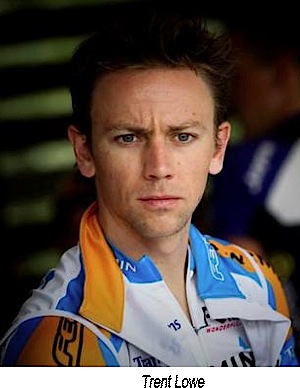 You see, to understand the complexities of this whole sordid mess, you need to understand that fifteen years ago Trent Lowe and Matt White were schoolmates in a notorious Australian children’s cycling school and prison. There, on the first day of school they got into a scuffle, because Matt thought that Lowe had been copying answers from his “Absolutist Ethics in Cycling” exam.
You see, to understand the complexities of this whole sordid mess, you need to understand that fifteen years ago Trent Lowe and Matt White were schoolmates in a notorious Australian children’s cycling school and prison. There, on the first day of school they got into a scuffle, because Matt thought that Lowe had been copying answers from his “Absolutist Ethics in Cycling” exam.
The fierce fight that ensued would become the stuff of school legend, due primarily to the innovative way in which bicycle parts were used as weapons, and secondarily due to the way nobody got even remotely injured, which in turn was due to the fact that both children were standing on concrete while wearing road cycling shoes at the time, and neither wanted to risk falling and becoming injured.
To all appearances, this event — far from making enemies of the two — cemented a friendship that would last for decades. In fact, the two would later laugh about it over drinks in their new capacities: Matt White as the director of a respected pro cycling team, Trent Lowe a racer for that team.
Imagine, then, the shock of those around them when it was discovered that White, known to all as a meticulous team director, would take a shortcut of having Lowe see a doctor who was known to all as a shady character.
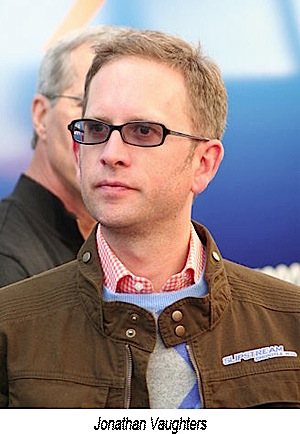 Vaughters, whose reputation for uncompromising honesty is only rivaled by his passion for looking dapper, could have none of this, and of course had to fire White.
Vaughters, whose reputation for uncompromising honesty is only rivaled by his passion for looking dapper, could have none of this, and of course had to fire White.
But that’s where the plot really starts to thicken.
Vaughters — as you’ll soon find verified by the rest of the cycling press — actually is the twin brother of the nefarious Dr. Luis Garcia del Moral, a fact which he only recently discovered when — just for fun — he tried growing a goatee. Suddenly, dodgy-looking cyclists from all over started approaching Vaughters, asking him to fill their prescriptions. Vaughters was of course confused by this seemingly nonsensical turn of events until Matt White informed him of the uncanny resemblance.
Without going into too much detail, let’s just say that after a dramatic confrontation with his mother, an angry letter to a DNA testing facility, and a trip to a Madrid hospital in the dead of night, Vaughters now knew that not only did he have a twin, but he had an evil twin engaged (allegedly) in the very thing Vaughters had sworn to spend his life fighting: illicit doping.
Thus was born a plan.
When Lowe — on White’s recommendation — visited Dr. Moral’s office, he — unbeknownst to him — was actually visiting a disguised Jonathan Vaughters, who was pretending to be Dr. Moral (as the real doctor was bound and gagged, unconcious, in a nearby broom closet).
Vaughters, of course, did his utmost to give Lowe sufficient opportunity to ask for doping help. And while plenty of doping innuendo hilariously ensued, with both parties hinting at doping without actually coming out and saying it, there was no smoking gun, and the two parted ways, with Lowe feeling like he had just received a physical from the most incompetent doctor, ever.
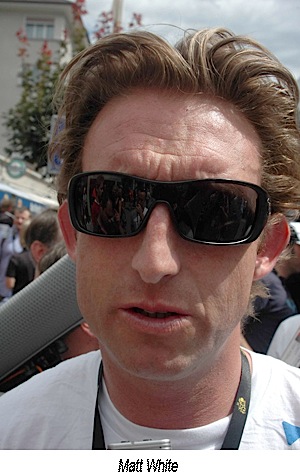 Now, flash forward to the near past. Lowe has confronted Vaughters with the damning evidence that he has been seeing another doctor. Vaughters, who in fact was that other doctor, has to feign incredulity, and — left with no other choice — fires the astounded White.
Now, flash forward to the near past. Lowe has confronted Vaughters with the damning evidence that he has been seeing another doctor. Vaughters, who in fact was that other doctor, has to feign incredulity, and — left with no other choice — fires the astounded White.
Now, we suddenly find out, Trent Lowe really holds a grudge. He hasn’t forgiven White for the fight the two of them were in nigh on fifteen years ago, and now he has gotten his revenge, and quite probably will find himself the owner of more than a hundred million naira.
But then, just when it seems Lowe’s victory is complete, Vaughters — dressed again as Dr. Moral — steps up to Lowe in a hotel lobby and then tears off the phony goatee.
Lowe’s head spins. But not literally. Different kind of story.
Instead, enraged, he attacks Vaughters. His advisor, Hardie, wades into the brawl, brandishing a gun and firing at random.
People scream and hit the deck. A chandelier crashes to the floor. And, in the confusion, Vaughters — his eye blackened and swollen in a very familiar fashion — extricates himself and makes a break for his bike. Lowe dashes after him, knocks a messenger off his bike, mounts, and gives pursuit.
Through the city they dash. One pursuing, one pursued. It goes on like this for several exciting minutes, and passersby can’t help but admire Vaughters for the way he manages to acquit himself on a bike, in spite of the fact that he has not been a pro in years, and also in spite of the fact that he is wearing a herringbone jacket and corduroy trousers.
Ultimately, though, Lowe catches Vaughters. They exchange a few punches, but both are winded from the dramatic chase, and have to sit down.
They begin to talk.
And it is while they talk that we discover — to our amazement! — that Trent Lowe is not a pro cyclist at all! Instead, he is really a grizzled cop (Martin Hardie is his partner) who has been working deep undercover as a pro cyclist, trying to find out who in the sport is doping, and to build a case that will stand up in court.
They exchange incredulous looks as they realize that they’ve been trying to sting each other for the exact same reasons. And then, just as they finish explaining everything to each other, Hardie — who is unable to ride a bike and so has had to give pursuit on foot — comically staggers up, winded, and demands Vaughters lay on the ground. Lowe laughs and explains.
And all is well.
Except, of course, Matt White, who is glowering. Brooding. Angry. With no job and no prospects, he has plenty of time to reflect on how he will get his revenge.
Which I will explain later. In Slipstream II: This Time It’s Personal.
Comments (43)
01.25.2011 | 2:43 pm
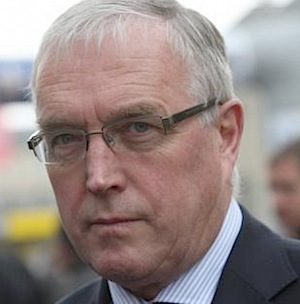
Dear Readers,
I’m Pat McQuaid, the President of UCI. As you are no doubt aware, the UCI’s mission is to improve every aspect of the cycling experience, through the medium of making it as bureaucratic and restrictive as possible.
Toward that end, last month we announced an exciting new program, which we lovingly call the “Approved by UCI” process. I’ll spare you the exciting details, but the basic idea is that we’d start making bike manufacturers submit prototypes of their bike frames to us for approval before they started manufacturing those frames.
We would then, at our leisure, forget about those frames for a while, then evaluate those frames, then express concern about the fact that they are not exactly the same as frames we have seen in the past.
Then we would have meetings. Lots of meetings. There would be committees. And subcommittees. We would speak earnestly and seriously about how inconvenient innovation is, and how much we enjoyed the year 1972.
We would make helpful suggestions for improving the submitted frames, such as, “What if you made the top tube four inches longer,” or, “I don’t see why you want to use carbon fiber. Isn’t that material kind of passe at this point?”
One thing we can promise we would not do is return the frame without comment, because then you’d think we hadn’t contributed to the process.
You would then have an opportunity to make revisions based upon our input and resubmit your design, at which point we would express concerns about an entirely different aspect of the frame.
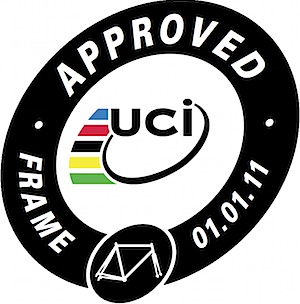 After a period of no more than nine months (and no less than eight), we would tell you that your frame design is approved. At this point, you could send us a lot of money as fair compensation for the help we had given you, and we would grant you the rights to use our “Approved” sticker.
After a period of no more than nine months (and no less than eight), we would tell you that your frame design is approved. At this point, you could send us a lot of money as fair compensation for the help we had given you, and we would grant you the rights to use our “Approved” sticker.
Also, we would send you a sympathy card that you had missed an entire race season while we haggled over your frames.
Because we care, that’s why.
The benefits of this program to the racing and riding communities are as numerous as they are obvious. Such as:
- The peace of mind cyclists will enjoy, knowing their bikes have been approved by an organization that wishes the world of cycling could be suspended in time.
- The knowledge that, should they choose to start racing, the 98% of cyclists who do not currently race on the road could in fact start racing, as long as they have a brand-new bike. Whew!
- Great value for the money: The sticker will only add a few dollars to the cost of most bikes!
- Awesome sticker! Personally, I’m pushing to have this sticker go where bike headbadges used to go, because approval by UCI will certainly give your bike prestige it would otherwise lack.
And I could go on.
So, there we were, all ready to launch. Then, the unthinkable happened.
The bike industry did not immediately fall in line, as we had instructed them to! Indeed, to our surprise and dismay, many people openly expressed that did not care for our new program.
They aired their petty grievances, such as that “it costs a lot of money without giving any value,” or “it slows down our manufacturing process” or “this is really nothing but a revenue stream for UCI.”
All of these claims are entirely ridiculous. True, sure, but still ridiculous.
So, in a display of maturity and collaboration the rest of you would all do well to emulate, we invited comment, listened to the bike industry. We then went back to the drawing board and are hard at work refining the “Approved by UCI” program.
And while there are still a number of details we’re finalizing, I’m happy today to give you a preview of what you can expect from the new and improved “Approved by UCI” program, coming soon to a bike shop near you!
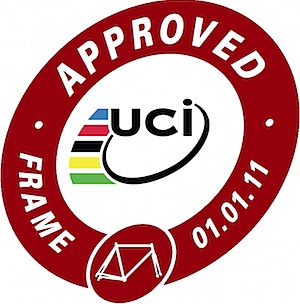 1. Exciting New Sticker Colors!
1. Exciting New Sticker Colors!
In addition to the sticker with the oval in black, you will now be able to get the sticker in red (shown here), beige (popular with the Footon-Servetto team), and ochre (popular in Australia!). This will allow you to match your UCI Approval sticker to the color of paint you choose for your frame.
Please be aware that, due to the aesthetics of the colors we have selected for our stickers, UCI will simultaneously begin regulating the colors frames may be painted. Which is to say, if you want a red sticker, you may have either a red or black frame. If you want a beige sticker, you must have a beige frame. If you want an ochre sticker, you must have an orange frame.
Orange goes great with ochre. Trust us on this. We know what we’re doing here.
No other colors, nor color combinations, will be allowed. Further, you must go with the specific hue of the selected color specified by the UCI.
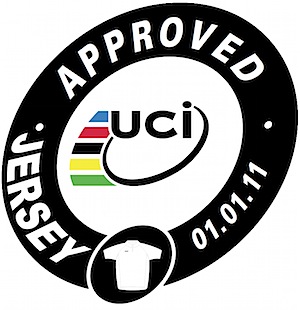 2. Exciting New Areas of Regulation!
2. Exciting New Areas of Regulation!
It doesn’t take a genius to look at the “Approved by UCI” logo to see that frames are just the beginning. When we roll out our revised regulations, you’ll be required to be very pleased to note that many other components of the cycling lifestyle will have regulations that must be met. We have already established regulations for jerseys (see preliminary logo), shorts, socks, shoes, helmets, energy bars, hypodermic needles, energy drinks, aerosol-powered cheez-food products, helmets, canned meats, vowels, brakes, cassettes, cable housing, lumber, blankets, GPS devices, music players and headphones, music genres, gloves, hairstyles, wheels, tires, tubes, forks, spoons, chocolate treats, breakfast cereals, shrubbery, training videos, magazines, sunglasses, books, and blogs.
Indeed, we are currently working on regulations for UCI-approved logos. Which means bike companies will actually be able to (required to, actually) include our logo as part of their logos.
This, I think you’ll agree, is very exciting indeed.
3. New Pricing Structure!
Originally, there were considerable complaints from the bicycle industry that our “Approved by UCI” program was prohibitively expensive, adding a new cost to an expensive R&D process in and industry was already plagued with razor-thin margins.
Well, we are happy to announce that, due to the expense and time we’ve incurred by revising these plans, that the “Approved by UCI” program will now be only 15% more expensive than previously announced.
What, you didn’t think our time is free, did you? Somebody has to pay for the effort we’ve put into these revisions.
And that pretty much wraps up the changes you can expect. Except the process will take twice as long as originally expected, too. But let’s not bother with minutia like that.
I’m sure that you are — as I am — very excited about this new program in general, and the revisions in particular. Further, I think we can now definitively dismiss the notion that UCI is out of touch with the cycling world.
Best Regards,

Pat McQuaid
President, UCI
Comments (63)
01.24.2011 | 2:29 pm
I like surprises. For example, if someone were — for no reason at all — to tap me on the shoulder and give me a White Chocolate Chip and Macademia Nut cookie, I would be both surprised and delighted.
Or if a person were to surprise me with a hilarious pun, I’d be delighted, and very surprised. Mostly because I have a hard time believing there’s such a thing as a hilarious pun. (While slapstick may be the lowest form of humor, puns are the lamest. Which gives rise to the question: is it worse to be lame or low? I’ll let you decide.)
Or if, right as I were to finish writing this paragraph, a person were to suddenly appear in my office door and throw a pie in my face, I’d be surprised and extremely delighted. I’d be surprised because my office is in my otherwise empty house and I’m not expecting any pie-bearing pranksters at the moment. And I’d be delighted because a pie in the face at that moment would be ironic slapstick, which is in fact the second-highest form of humor (fart jokes are the highest).
Also, I would be delighted, because I really like pie.
By the way, I am disappointed (but not surprised) to announce that no pie-throwing people materialized as I completed either of the preceding two paragraphs.
Anyway, I believe I have sufficiently proven that I like surprises.
Wherein I am Promised a Tour de France Surprise
Since — as I believe I have convincingly described — I like surprises, I was very excited when, on January 14, I read in Cyclingnews that the Tour de France wildcards would shortly be announced.
Why would this excite me? Well, because, according to Cyclingnews:
Traditionally, the attribution of wildcards was done in spring, to give the teams some time to prove their worth. But this year, ASO’s technical director Jean-François Pescheux revealed to Cyclism’Actu that the organiser wanted to designate the participating teams as soon as the end of January.
Moreover, “several surprises” could be on hand according to Pescheux.
You see that last paragraph in that there block quote? According to Pescheux, there could be several surprises revealed as part of the 2011 Tour de France!
Not just one little surprise. Several of them. How could I not be excited?
I began to wait, eagerly. Intrigued. Excited for what would surely be a delightful surprise.
Several delightful surprises, I mean.
Wherein I Fail to Be Surprised by ASO’s Surprises
I did not have to wait long. On January 20th, ASO — the organizer of the Tour de France — announced which teams would be racing in the 2011 Tour de France. Here is a list of the things that could maybe be called surprising from that announcement:
- All four of the “wildcard” teams — teams that are invited at ASO’s discretion, even though the teams are not one of the ProTeams — are French teams. Specifically: Cofidis, FDJeux, Saur-SojaSun, and Europcar.
- Geox-TMC did not receive an invitation, even though Carlos Sastre and Denis Menchov — two heavy-hitting pros — are on that team.
I confess: I was disappointed by the calibre of these surprises. Sure, I was mildly surprised that ASO would be so openly jingoistic as to invite only French teams as its wildcard selections, but it was more of a single eye-roll than a triple-take with a “whaaaaah?”
And honestly, I wasn’t at all surprised that Geox-TMC wasn’t invited; this move was a direct parallel to the way Astana wasn’t invited the year after they got chucked out, mid-tour.
Though I will confess: I was a little bit bummed out that ASO didn’t have the courage to admit that it this non-invitation was actually in retaliation for the Footon-Servetto kit debacle of 2010.
“That’s it?” I found myself asking. “That’s the several surprises you promised me? Pffff.”
Surprises I Wish I Had Been Surprised With
I spent the rest of the day moping, surprised at how melancholy I felt about how unsurprising ASO’s surprises were.
What a wasted opportunity. A chance, as it were, to truly do something surprising and fresh and exciting with the Tour.
They could have, for example, surprised me much better with any of the following:
New Wildcard Selection Technique
Suppose ASO had announced that the four wildcard teams had not been selected using team nationality as its primary metric, and randomness as its secondary metric. That, instead, it had decided to choose teams based on something interesting. Such as:
- Team with most awesome mascot
- Team sponsored by company most likely to throw really cool schwag out to the spectators
- Team made up entirely of celebrity impersonators
- Team made up entirely of clones of Eddy Merckx (What? You think they’re not out there? You just haven’t heard of them because Eddy’s been training them in seclusion for the past three years, every since he sold his bike company)
- Team that’s demonstrated it’s really, really fast and has demonstrated that it deserves a shot at racing against the ProTeams.
OK, I admit. That last one was kind of nuts.
New Rules
Sure, I enjoy the Tour de France. Sure, I enjoy tradition. And sure, I love all the action that happens at the front of the field in each stage.
But honestly, I get a little bit disgusted with those guys dogging it at the back of the peloton. The “Well, I’m not in contention today, so I think I’ll just save my energy and cruise today, even though I’m in the middle of a race.
Slackers.
Hence, ASO needs to bring in the “voted off the island” gameplay in reality shows. On sprinting stages, I suggest that the last sprinter across the line is out of the race. On mountaintop finishes, the last climber to the top of the mountain: out of the race. The slowest team on a TTT stage? Out of the race.
I guarantee that we’d see new urgency at the back of the pack.
Oh, and also there needs to be a stage where they have to eat live polligwogs or something before they can proceed.
New Course
Alpe d’Huez. Uh huh. Galibier. Sure. Mont Ventoux. Mmm hmm. Champs Elysees. Whatever.
When’s the last time we’ve been surprised by a Tour de France course?
I’d like to see ASO announce that there’ll be a cyclocross stage. And a mountain bike stage. And a track stage. And a BMX stage. When we get to Paris, we’ll know who the real best cyclist in the world is.
Which would be kind of a cool surprise.
Comments (38)
01.20.2011 | 9:51 am
A quick post today, because things are heating up here, work-wise. Plus, I chose to go on a run on the beach this morning instead of doing a lot of writing. Wrong choice? I would hope you would agree that it’s not.
So. I would like to put forward, for discussion, an idea I’ve been thinking about pretty often while I’ve been here at Cocoa Beach, Florida for a week-long business meeting.
The idea is this: Diet by Overindulgence. Specifically, I’m beginning to think that a good way to kick a bad food habit is to associate it with something bad, and a good way to associate any kind of food with something bad is to eat so much of it that you get sick.
My first experience with this idea was when I visited the Fazer chocolate factory in Helsinki, Finland. During that tour, visitors are allowed — encouraged even — to sample as much of the chocolate as they like. No charge.
By the time I left, I hated chocolate, and had made a solemn promise to myself that I would never eat chocolate again.
And you know, I actually kept that promise. For a couple of months, anyway.
Now, at this conference, I’m considering a similar vow, but for food in general. This is because we are eating constantly.
Big breakfast at a restaurant. Brunch snacks brought into the conference room. An endlessly-deep bowl of candy bars sitting on the conference table (Twix, Kit Kat, Snickers, Reese’s, Hershey’s plain — all my favorites). Lunch brought in — sandwiches, chips, and soda. A big dinner at a nice restaurant (Thai the first night, Cuban the second, Italian last night).
I don’t think I’ve ever eaten so heavily. I am all restauranted out. I’m genuinely sick of rich food and am looking forward to getting back home and having nothing but salad and egg whites for the rest of my life.
So, is there any merit to this idea? Start a diet by eating so heavily that you are repulsed by the stuff you’re normally attracted to?
Personally, I think it’s a great idea, and that there’s no possible way it could backfire.
Comments (67)
« Previous Entries Next Page »

 You see, to understand the complexities of this whole sordid mess, you need to understand that fifteen years ago Trent Lowe and Matt White were schoolmates in a notorious Australian children’s cycling school and prison. There, on the first day of school they got into a scuffle, because Matt thought that Lowe had been copying answers from his “Absolutist Ethics in Cycling” exam.
You see, to understand the complexities of this whole sordid mess, you need to understand that fifteen years ago Trent Lowe and Matt White were schoolmates in a notorious Australian children’s cycling school and prison. There, on the first day of school they got into a scuffle, because Matt thought that Lowe had been copying answers from his “Absolutist Ethics in Cycling” exam. Vaughters, whose reputation for uncompromising honesty is only rivaled by his passion for looking dapper, could have none of this, and of course had to fire White.
Vaughters, whose reputation for uncompromising honesty is only rivaled by his passion for looking dapper, could have none of this, and of course had to fire White. Now, flash forward to the near past. Lowe has confronted Vaughters with the damning evidence that he has been seeing another doctor. Vaughters, who in fact was that other doctor, has to feign incredulity, and — left with no other choice — fires the astounded White.
Now, flash forward to the near past. Lowe has confronted Vaughters with the damning evidence that he has been seeing another doctor. Vaughters, who in fact was that other doctor, has to feign incredulity, and — left with no other choice — fires the astounded White.
 After a period of no more than nine months (and no less than eight), we would tell you that your frame design is approved. At this point, you could send us a lot of money as fair compensation for the help we had given you, and we would grant you the rights to use our “Approved” sticker.
After a period of no more than nine months (and no less than eight), we would tell you that your frame design is approved. At this point, you could send us a lot of money as fair compensation for the help we had given you, and we would grant you the rights to use our “Approved” sticker. 1. Exciting New Sticker Colors!
1. Exciting New Sticker Colors! 2. Exciting New Areas of Regulation!
2. Exciting New Areas of Regulation!